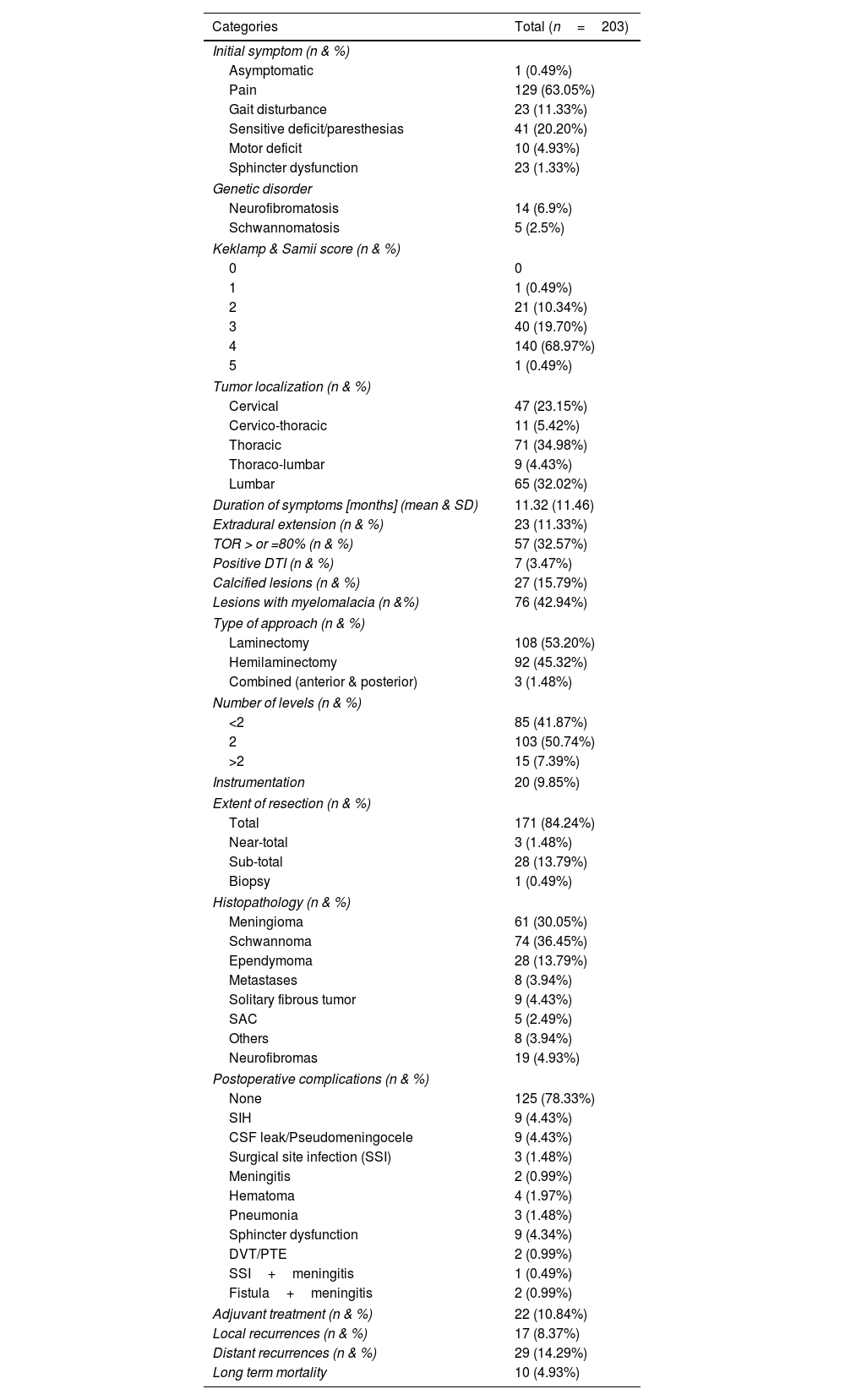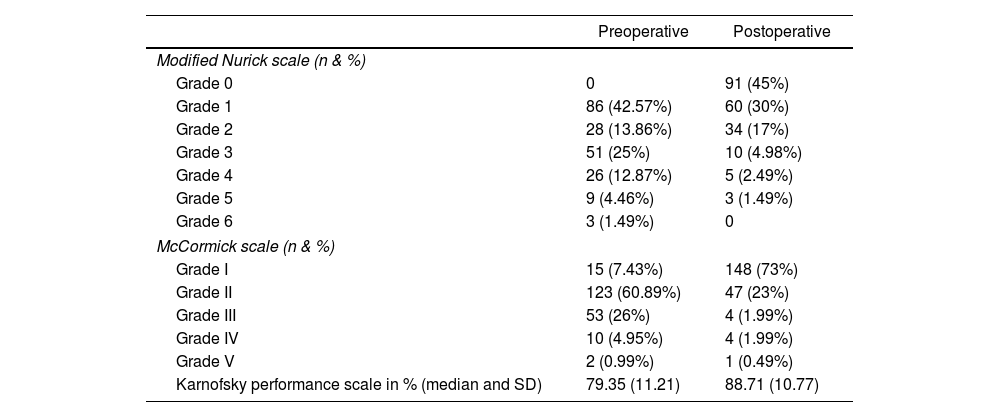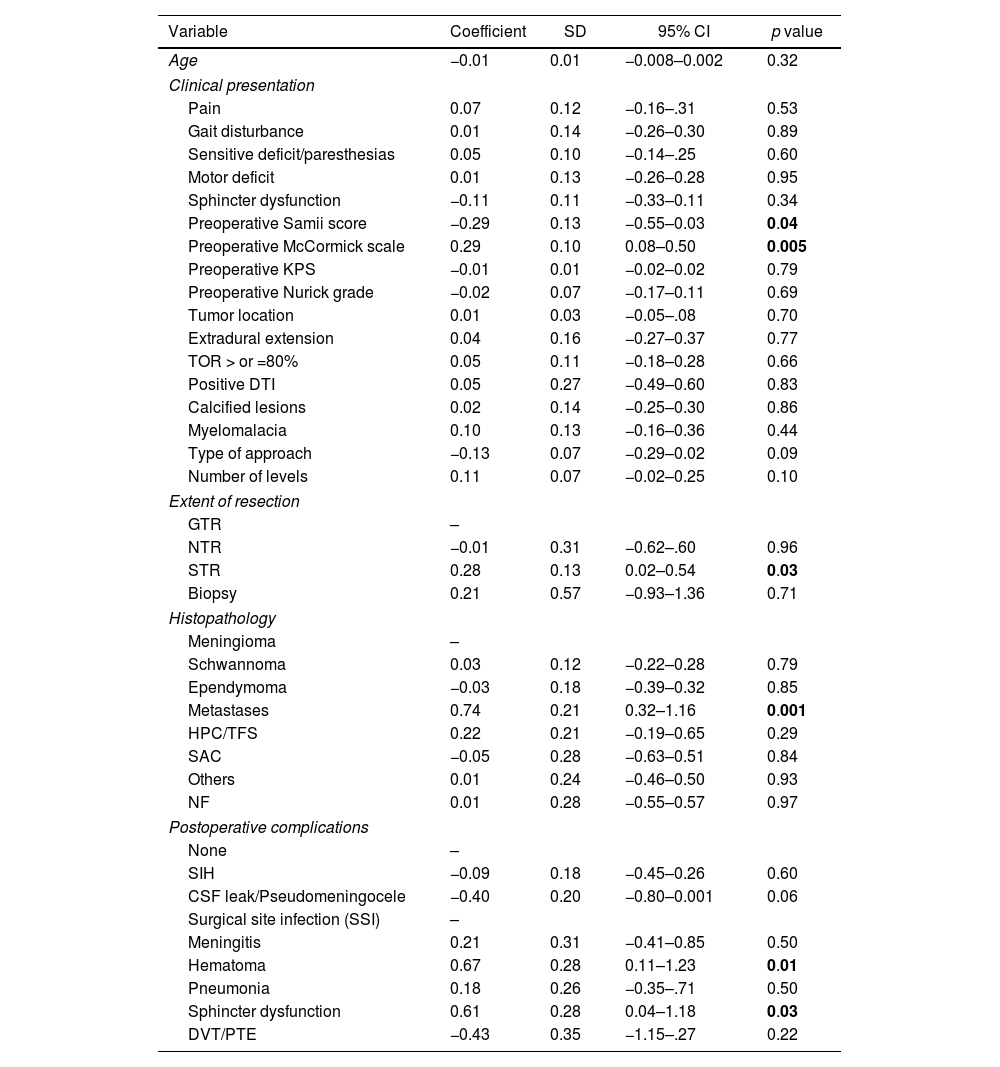The purpose of this study is to analyze a series of patients with intradural extramedullary tumors (IDEM) and assess factors that may modify or determine the final long term outcome and management.
Materials and methodsSingle Center, retrospective study of a series of surgical patients with IDEM lesions from our Institution operated between 2010 and 2021. Patients with less than 6 months of follow up were excluded. Several preoperative demographics, clinical, imaging and surgical features, as well as histopathology, recurrence and adjuvancy were assessed. Patients’ final clinical outcome was categorized using the McCormick scale.
ResultsA total of 203 patients with a mean follow-up of 30.50 months (range 6–130) were included. 57.64% of the analyzed population was female and the mean age was 50.51 years.
The most frequent location of the tumors was dorsal (34.98%) followed by the lumbar region (32.02%). Total resection was achieved in 84.24% of cases, and the most frequent histopathology was Schwannoma (36.45%), followed by Meningioma (30.05%). Pain was the most usual initial symptom (63.05%).
In our analysis, functional outcome after surgery was associated with statistical significance with preoperative McCormick grade, tumor type, EOR and postoperative complications such as hematoma and sphincter involvement.
ConclusionThe management of these lesions depends on many factors. It is worthy of mention that clinical presentation, EOR, histopathology and postoperative complications have shown significant prognostic value for the final outcome. Early treatment with the intention of achieving GTR when possible, using carefully tailored approaches, should be considered before the onset of significant symptoms.
Analizar una serie de pacientes con tumores intradurales extramedulares y evaluar factores que pueden modificar o determinar el resultado final y el manejo a largo plazo.
Materiales y métodosEstudio monocéntrico, retrospectivo de una cohorte de pacientes quirúrgicos con lesiones intradurales extramedulares (IDEM) operados entre 2010 y 2021 y un mínimo de seis meses de seguimiento. Se evaluaron características clínicas, de imagen y quirúrgicas, histopatología, recurrencia y adyuvancia. El resultado clínico final de los pacientes se categorizó utilizando la escala de McCormick.
ResultadosSe incluyeron un total de 203 pacientes con un seguimiento medio de 30,50 meses (rango 6-130). De la población analizada, 57,64% era del sexo femenino y la edad media fue de 50,51 años.
La localización más frecuente de los tumores fue dorsal (34,98%) seguida de la región lumbar (32,02%). La resección total se logró en 84,24% de los casos, y la histopatología más frecuente fue el schwannoma (36,45%), seguido del meningioma (30,05%). El dolor fue el síntoma inicial más habitual (63,05%).
En nuestro análisis, el resultado funcional posoperatorio se asoció con significancia estadística con el grado de McCormick preoperatorio, la histopatología, el grado de resección y las complicaciones posoperatorias como el hematoma y la afectación esfinteriana.
ConclusiónEl manejo de estas lesiones depende de muchos factores. Cabe mencionar que la presentación clínica, el grado de resección, la histopatología y las complicaciones posoperatorias han mostrado un importante valor pronóstico para el desenlace. Se debe considerar el tratamiento temprano con la intención de lograr resección total cuando sea posible, mediante abordajes cuidadosamente adaptados, antes de la aparición de síntomas significativos.
Article

If it is the first time you have accessed you can obtain your credentials by contacting Elsevier Spain in suscripciones@elsevier.com or by calling our Customer Service at902 88 87 40 if you are calling from Spain or at +34 932 418 800 (from 9 to 18h., GMT + 1) if you are calling outside of Spain.
If you already have your login data, please click here .
If you have forgotten your password you can you can recover it by clicking here and selecting the option ¿I have forgotten my password¿.















